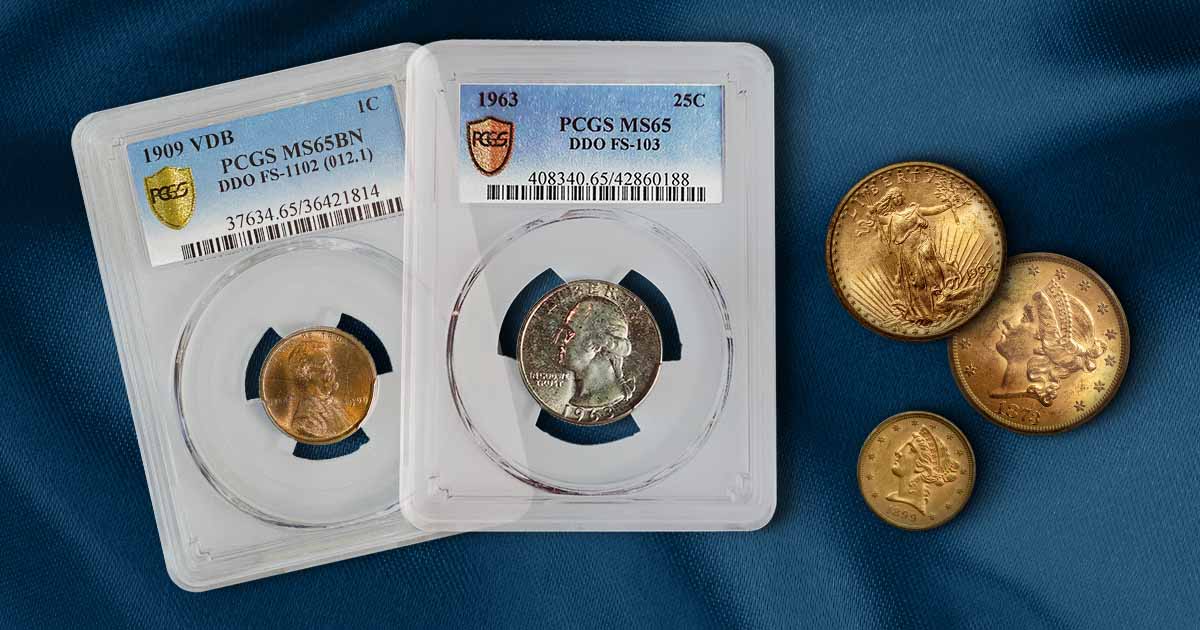
If you have seen FS on a coin slab that was not a Jefferson nickel with a Full Steps designation, it may have had a 3-digit trailing number, like FS-101. The FS, or Fivaz-Stanton number used here represents the last names of two authors, Bill Fivaz and J.T. Stanton, and the number indicates a unique die variety. Fivaz and Stanton’s book, Cherrypicker’s Guide to Rare Die Varieties of United States Coins, was first published in 1990 and is in its sixth edition at the time of this writing.
What is the Cherrypickers’ Guide to Rare Die Varieties of U.S. Coins?
First published in 1990, the Cherrypicker’s Guide to Rare Die Varieties of United States Coins is the result of years of painstaking research identifying and cataloging rare and unique die varieties. The book is intended to help collectors “cherry pick” hidden gems among seemingly pedestrian coins. It does so with detailed descriptions, close-up photographs, and market values for more than 680 identified die varieties across many issues of United States coins.
The book is available in three volumes, each covering different coin types from the 1800s to the present.
Volume I
The first volume of the Cherrypickers’ Guide to Rare Die Varieties of U.S. Coins contains information on more than 680 die varieties. Volume I covers the half cent, large and small cent, two-cent pieces, three-cent pieces, and nickels.
Volume II
The second volume of the Cherrypicker’s Guide to Rare Die Varieties of U.S. Coins includes 442 die varieties. Volume II covers the half dime, dime, twenty cent piece, and quarter dollar.
Volume III
The third volume of the Cherrypickers’ Guide to Rare Die Varieties of U.S. Coins contains information on 310 die varieties. Volume III includes half dollars, dollars, gold dollars through $20 Double Eagles, and bullion coins.
How Does Cherrypickers’ Guide Help Collectors?
Fivaz and Stanton encourage collectors to identify coins for unusual characteristics and provide their assessments around their rarity, general interest, liquidity, and value. Some of the features they use include:
Doubled Dies
Doubled dies occur when a coin die has been engraved with a design that has shifted or been duplicated, in part or whole. Doubled dies leave a double image on the coins they strike.
Tripled Dies
Tripled dies are similar to doubled dies but result in a tripled image on the coins they strike.
Overdates
When coins have a date stamped over another date, they are called overdates. Overdates are more commonly found on older coins than on newer coins.
Repunched Mintmarks
When the mintmark on a coin has been stamped more than once, it sometimes results in shifted and overlapping marks.
Fivaz-Stanton Numbers
| Numbers | Indication |
| 101-299 | Obverse doubled date and/or obverse die variety |
| 301-399 | Obverse date variety |
| 401-499 | Miscellaneous obverse variety |
| 501-699 | Mint mark variety |
| 701-799 | Miscellaneous variety |
| 801-899 | Reverse doubled die |
| 901-999 | Miscellaneous reverse variety |
Who are Bill Fivaz and J.T. Stanton?
J.T. Stanton
J.T. Stanton was born on March 5, 1952, and nurtured a lifelong passion for numismatics. Stanton led classes at the American Numismatic Association (ANA) Summer Seminars for many years and received numerous ANA awards, including the ANA Presidential Award in 1998. He served on the Board of Directors and as President of the Combined Organization of Numismatic Error Collections of America (CONECA) before induction into the Hall of Fame in 2003. J.T. passed away on October 19, 2018.
Bill Fivaz
Bill Fivaz was born on February 26, 1934, and has been named one of Coin World’s Most Influential People in Numismatics for his dedicated work from 1960 through 2020. In addition to the Cherrypickers’ Guide, Fivaz has published several books on numismatics, including the United States Gold Counterfeit Detection Guide and Helpful Hints for Enjoying Coin Collecting.




